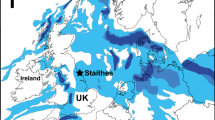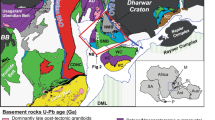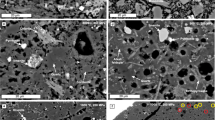Abstract
SMITH and Croxford1 have reported important new measurements of variations among the isotopes of sulphur in the enigmatic stratiform sulphide deposit at McArthur River, Northern Territory, Australia. The data place severe constraints on processes capable of forming the deposit, and Smith and Croxford interpret them to indicate a syn-sedi-mentary origin with sulphur supplied from two separate sources—one for pyrite and one for galena and sphalerite. We suggest that Smith and Croxford have misinterpreted several important aspects of their data and that they have thereby been led to erroneous conclusions. The isotopic data do not really support their preferred models of mineralisation. Rather, they support the kind of single-sulphur source model demonstrated for many other stratiform base-metal sulphide deposits, in which dissolution of pre-existing pyrite by a circulating, metal-rich but sulphur-poor brine is followed by deposition of base-metal sulphides. Brines of the kind capable of forming such deposits have been reported from the Salton Sea geothermal field2, from the Cheleken region in Russia3, in oil fields4 and in fluid inclusions5. The most complete elucidation of such a model is that by Brown6 for the White Pine deposit in Michigan but the applicability of the model to many deposits has been pointed out by White7 and others.
This is a preview of subscription content, access via your institution
Access options
Subscribe to this journal
Receive 51 print issues and online access
$199.00 per year
only $3.90 per issue
Buy this article
- Purchase on Springer Link
- Instant access to full article PDF
Prices may be subject to local taxes which are calculated during checkout
Similar content being viewed by others
References
Smith, J. W., and Croxford, N. J. W., Nature phys. Sci., 245, 10 (1973).
White, D. E., Anderson, E. T., and Grubbs, D. K., Science. N.Y., 139, 919 (1963).
Lebedev, L. M., Dokl. Akad. Nauk. SSSR (Engl. Trans. Earth Sci. Sect.), 174, 173 (1967).
Hall, W. E., and Friedman, I., Econ. Geol., 58, 886 (1963).
Czamanske, G. K., Roedder, E., and Burns, F. C., Science, N.Y,. 140, 401 (1963).
Brown, A. C., Econ. Geol., 66, 543 (1971).
White, D. E., Econ. Geol., 63, 301 (1968).
Kajiwara, Y., and Krouse, H. R., Can. J. Earth Sci., 8, 1397 (1971).
Czamanske, G. K., and Rye, R. O., Econ. Geol. (in the press).
Kemp, A. L. W., and Thode, H. G., Geochim. cosmochim. Acta, 32, 7l (1968).
Sakai, H., Geochem. J., 2, 29 (1968).
Croxford, N. J. W., and Jephcott, S., Proc. Australas. Inst. Min. Metall., 243, 1 (1972).
Cotton, R. E., in Geology of Australian Ore Deposits (edit. by McAndrew, J.), 197 (Min. Metall. Congress, Melbourne, 1965).
Croxford, N. J. W., Proc. Australas. Inst. Min. Metall., 226, 97 (1968).
Author information
Authors and Affiliations
Rights and permissions
About this article
Cite this article
WILLIAMS, N., RYE, D. Alternative interpretation of sulphur isotope ratios in the McArthur lead-zinc-silver deposit. Nature 247, 535–537 (1974). https://doi.org/10.1038/247535a0
Received:
Revised:
Issue Date:
DOI: https://doi.org/10.1038/247535a0
This article is cited by
-
The Rosie pyrite hydrothermal system in the McArthur Basin: tectono-sedimentary constraints on mineralization and alkali metasomatism in stratiform sediment-hosted sulfide deposits of northern Australia
Mineralium Deposita (2022)
-
Isotopic and geochemical studies on crustal effects in the genesis of the woodlawn Pb-Zn-Cu deposit
Contributions to Mineralogy and Petrology (1977)
Comments
By submitting a comment you agree to abide by our Terms and Community Guidelines. If you find something abusive or that does not comply with our terms or guidelines please flag it as inappropriate.



